在本教程中,我们将构建一个程序,该程序可以使用流行的计算机视觉库 OpenCV 确定对象的方向(即以度为单位的旋转角度)。
最常见的现实世界用例之一是当您想要开发机械臂的取放系统时。确定一个物体在传送带上的方向是确定合适的抓取、捡起物体并将其放置在另一个位置的关键。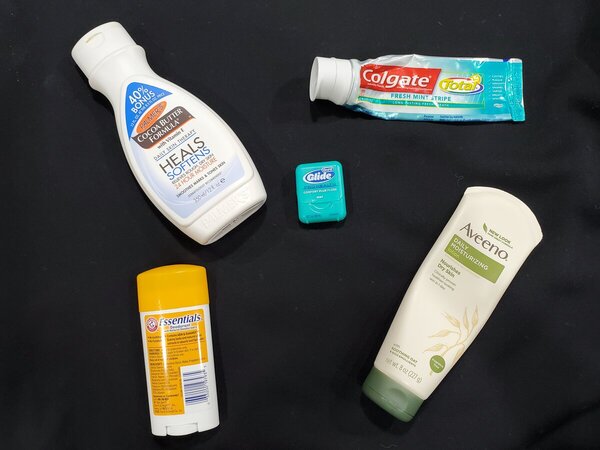
1.代码实现
接受一个名为
input_img.jpg
的图像,并输出一个名为
output_img.jpg
的带标记的图像。部分代码来自官方的OpenCV实现。
import cv2 as cv
from math import atan2, cos, sin, sqrt, pi
import numpy as np
defdrawAxis(img, p_, q_, color, scale):
p =list(p_)
q =list(q_)## [visualization1]
angle = atan2(p[1]- q[1], p[0]- q[0])# angle in radians
hypotenuse = sqrt((p[1]- q[1])*(p[1]- q[1])+(p[0]- q[0])*(p[0]- q[0]))# Here we lengthen the arrow by a factor of scale
q[0]= p[0]- scale * hypotenuse * cos(angle)
q[1]= p[1]- scale * hypotenuse * sin(angle)
cv.line(img,(int(p[0]),int(p[1])),(int(q[0]),int(q[1])), color,3, cv.LINE_AA)# create the arrow hooks
p[0]= q[0]+9* cos(angle + pi /4)
p[1]= q[1]+9* sin(angle + pi /4)
cv.line(img,(int(p[0]),int(p[1])),(int(q[0]),int(q[1])), color,3, cv.LINE_AA)
p[0]= q[0]+9* cos(angle - pi /4)
p[1]= q[1]+9* sin(angle - pi /4)
cv.line(img,(int(p[0]),int(p[1])),(int(q[0]),int(q[1])), color,3, cv.LINE_AA)## [visualization1]defgetOrientation(pts, img):## [pca]# Construct a buffer used by the pca analysis
sz =len(pts)
data_pts = np.empty((sz,2), dtype=np.float64)for i inrange(data_pts.shape[0]):
data_pts[i,0]= pts[i,0,0]
data_pts[i,1]= pts[i,0,1]# Perform PCA analysis
mean = np.empty((0))
mean, eigenvectors, eigenvalues = cv.PCACompute2(data_pts, mean)# Store the center of the object
cntr =(int(mean[0,0]),int(mean[0,1]))## [pca]## [visualization]# Draw the principal components
cv.circle(img, cntr,3,(255,0,255),2)
p1 =(cntr[0]+0.02* eigenvectors[0,0]* eigenvalues[0,0], cntr[1]+0.02* eigenvectors[0,1]* eigenvalues[0,0])
p2 =(cntr[0]-0.02* eigenvectors[1,0]* eigenvalues[1,0], cntr[1]-0.02* eigenvectors[1,1]* eigenvalues[1,0])
drawAxis(img, cntr, p1,(255,255,0),1)
drawAxis(img, cntr, p2,(0,0,255),5)
angle = atan2(eigenvectors[0,1], eigenvectors[0,0])# orientation in radians## [visualization]# Label with the rotation angle
label =" Rotation Angle: "+str(-int(np.rad2deg(angle))-90)+" degrees"
textbox = cv.rectangle(img,(cntr[0], cntr[1]-25),(cntr[0]+250, cntr[1]+10),(255,255,255),-1)
cv.putText(img, label,(cntr[0], cntr[1]), cv.FONT_HERSHEY_SIMPLEX,0.5,(0,0,0),1, cv.LINE_AA)return angle
# Load the image
img = cv.imread("input_img.jpg")# Was the image there?if img isNone:print("Error: File not found")
exit(0)
cv.imshow('Input Image', img)# Convert image to grayscale
gray = cv.cvtColor(img, cv.COLOR_BGR2GRAY)# Convert image to binary
_, bw = cv.threshold(gray,50,255, cv.THRESH_BINARY | cv.THRESH_OTSU)# Find all the contours in the thresholded image
contours, _ = cv.findContours(bw, cv.RETR_LIST, cv.CHAIN_APPROX_NONE)for i, c inenumerate(contours):# Calculate the area of each contour
area = cv.contourArea(c)# Ignore contours that are too small or too largeif area <3700or100000< area:continue# Draw each contour only for visualisation purposes
cv.drawContours(img, contours, i,(0,0,255),2)# Find the orientation of each shape
getOrientation(c, img)
cv.imshow('Output Image', img)
cv.waitKey(0)
cv.destroyAllWindows()# Save the output image to the current directory
cv.imwrite("output_img.jpg", img)
2.输出图像
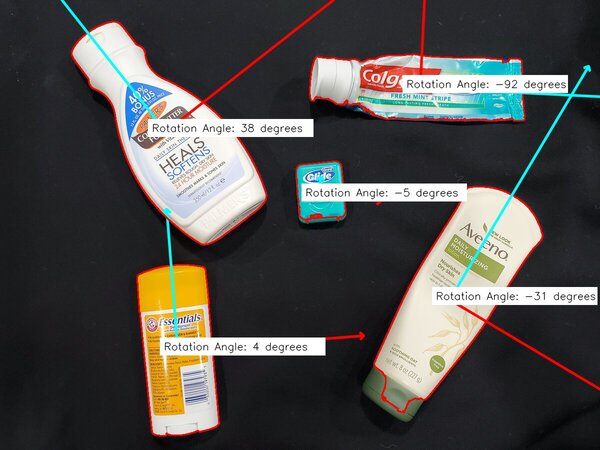
3.了解坐标轴
红线表示每个物体的正x轴。蓝线表示每个物体的正y轴。
全局正x轴从左到右横贯图像。整体正z轴指向这一页外。全局正y轴从图像的底部垂直指向图像的顶部。
使用右手法则来测量旋转,你将你的四个手指(食指到小指)笔直地指向全局正x轴的方向。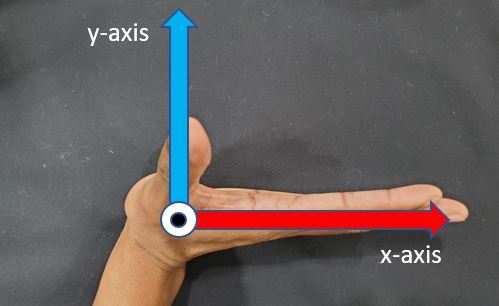
然后逆时针旋转四个手指90度。指尖指向y轴正方向,大拇指指向纸外z轴正方向。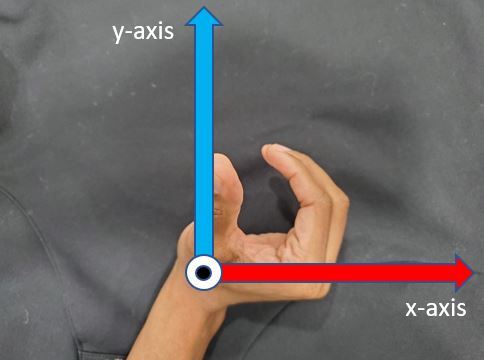
4.计算0到180度之间的方向
如果我们想计算一个对象的方向,并确保结果总是在0到180度之间,我们可以使用以下代码:
# This programs calculates the orientation of an object.# The input is an image, and the output is an annotated image# with the angle of otientation for each object (0 to 180 degrees)import cv2 as cv
from math import atan2, cos, sin, sqrt, pi
import numpy as np
# Load the image
img = cv.imread("input_img.jpg")# Was the image there?if img isNone:print("Error: File not found")
exit(0)
cv.imshow('Input Image', img)# Convert image to grayscale
gray = cv.cvtColor(img, cv.COLOR_BGR2GRAY)# Convert image to binary
_, bw = cv.threshold(gray,50,255, cv.THRESH_BINARY | cv.THRESH_OTSU)# Find all the contours in the thresholded image
contours, _ = cv.findContours(bw, cv.RETR_LIST, cv.CHAIN_APPROX_NONE)for i, c inenumerate(contours):# Calculate the area of each contour
area = cv.contourArea(c)# Ignore contours that are too small or too largeif area <3700or100000< area:continue# cv.minAreaRect returns:# (center(x, y), (width, height), angle of rotation) = cv2.minAreaRect(c)
rect = cv.minAreaRect(c)
box = cv.boxPoints(rect)
box = np.int0(box)# Retrieve the key parameters of the rotated bounding box
center =(int(rect[0][0]),int(rect[0][1]))
width =int(rect[1][0])
height =int(rect[1][1])
angle =int(rect[2])if width < height:
angle =90- angle
else:
angle =-angle
label =" Rotation Angle: "+str(angle)+" degrees"
textbox = cv.rectangle(img,(center[0]-35, center[1]-25),(center[0]+295, center[1]+10),(255,255,255),-1)
cv.putText(img, label,(center[0]-50, center[1]),
cv.FONT_HERSHEY_SIMPLEX,0.7,(0,0,0),1, cv.LINE_AA)
cv.drawContours(img,[box],0,(0,0,255),2)
cv.imshow('Output Image', img)
cv.waitKey(0)
cv.destroyAllWindows()# Save the output image to the current directory
cv.imwrite("min_area_rec_output.jpg", img)
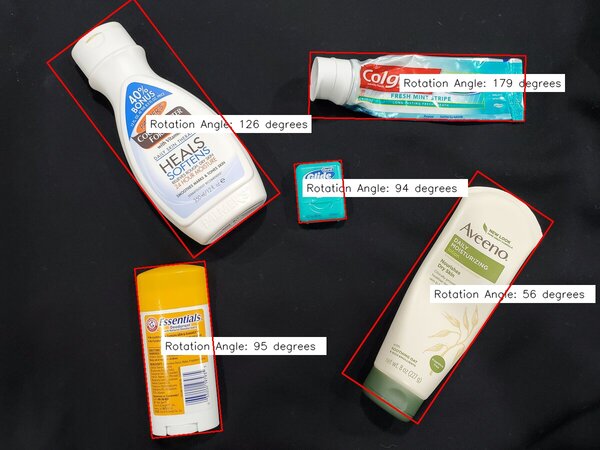
参考目录
https://automaticaddison.com/how-to-determine-the-orientation-of-an-object-using-opencv/
版权归原作者 求则得之,舍则失之 所有, 如有侵权,请联系我们删除。